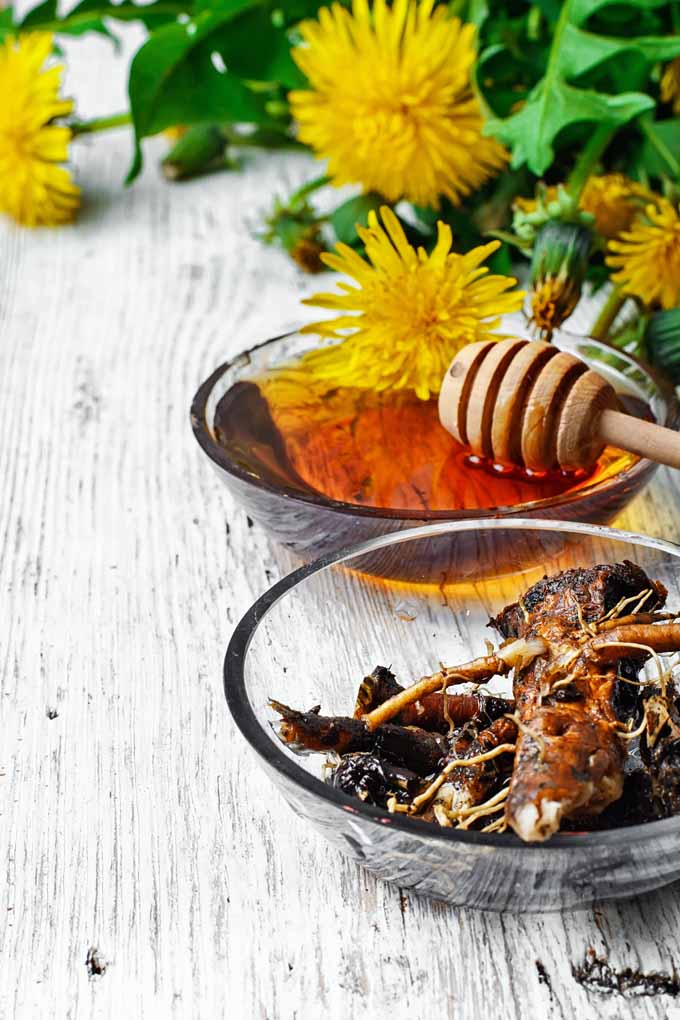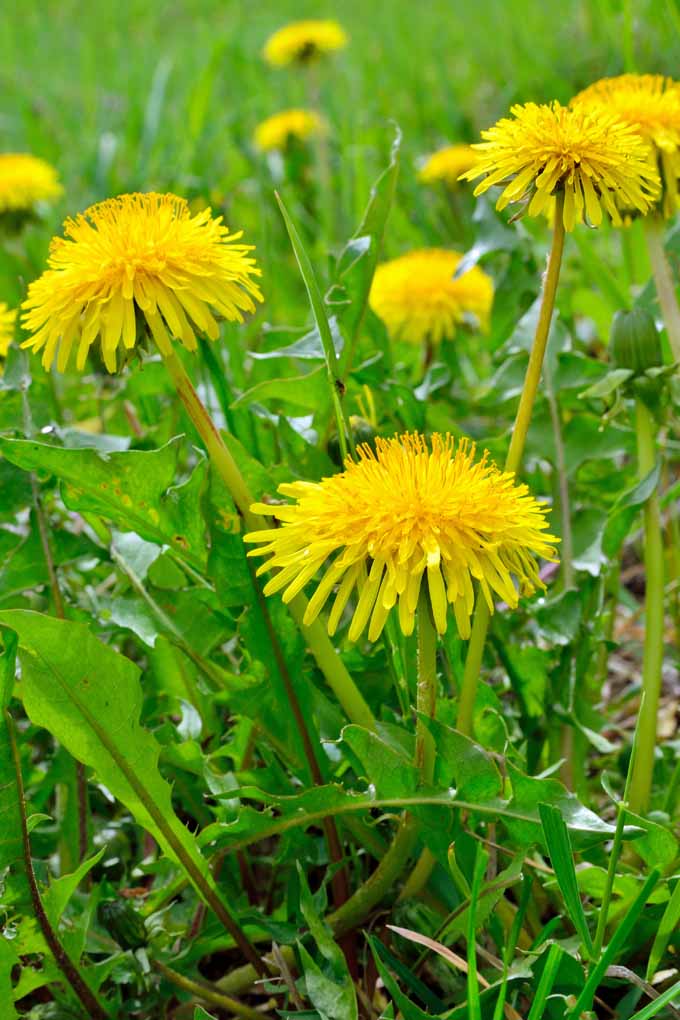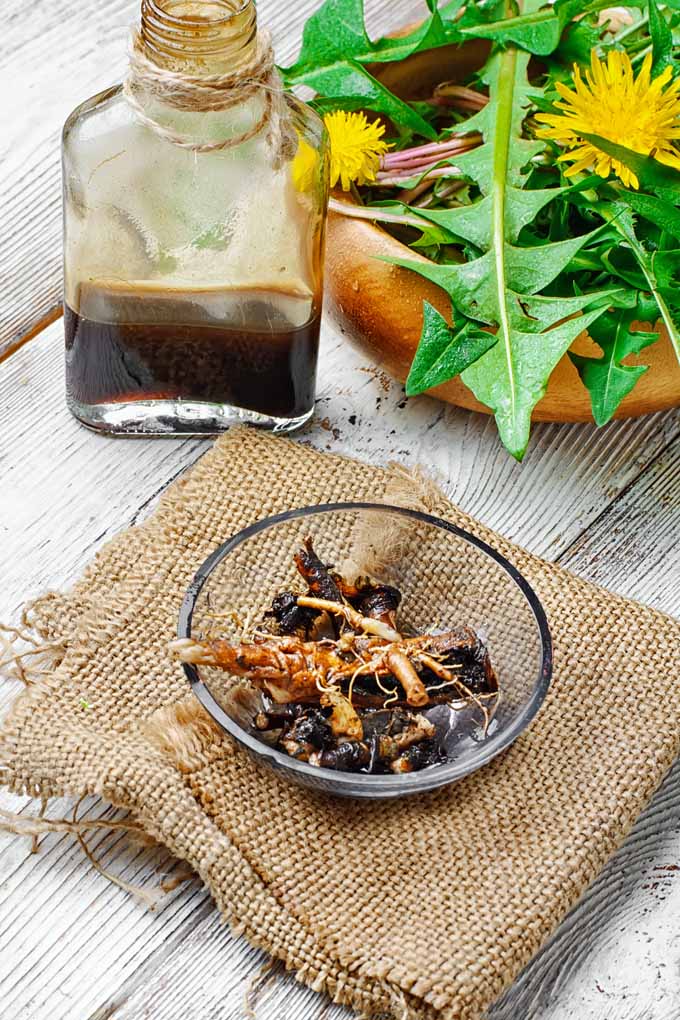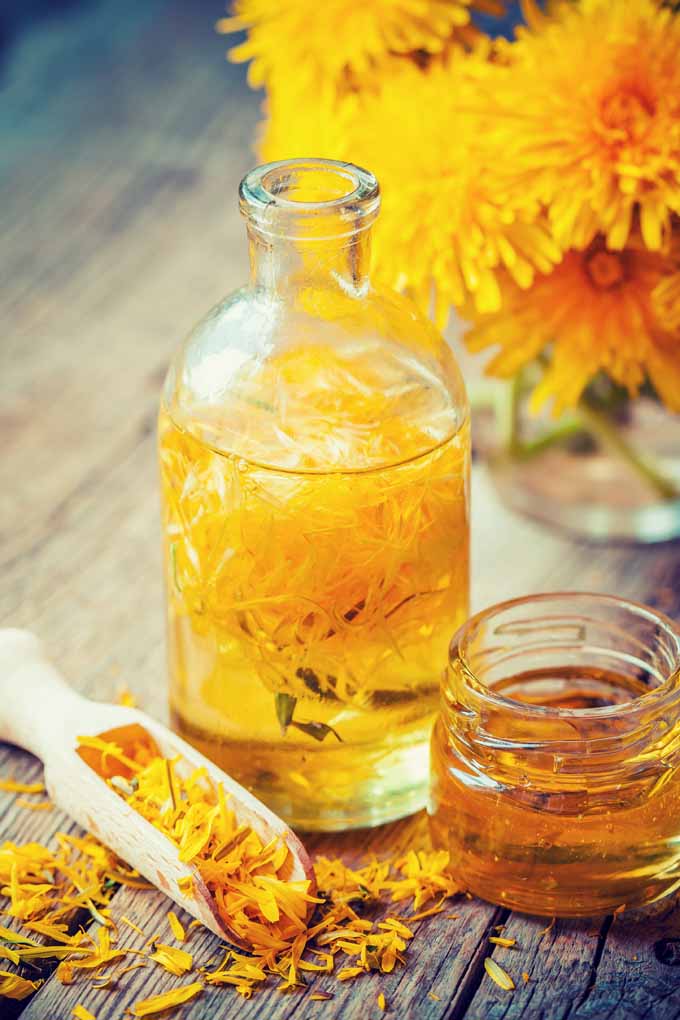But as most modern herbalists know, the dandelion is, in fact, a tasty, nutritious, useful, and above all, healthful herb. The roots are also extremely good for you, but stronger than the leaves, as you might expect. Roots are frequently tinctured (see below) and used as a liver tonic, heart tonic, an immune booster, and a source of potassium and vitamin C, both of which help to guard your body against cancer and cancer-causing free radicals. After all, in these modern times, we are exposed to a lot of toxins just by eating normally and walking around. Dandelions can help us detoxify. But there’s more: Dandelion leaves may also help to reduce blood cholesterol and high blood pressure. How’s that for free medicine?
The root can even be used for treating cases of anemia in those with blood sugar problems, as the herb may help to balance blood sugar levels. It’s also used as a treatment for all kinds of menstrual and premenstrual difficulties including cramps, fluid retention, and breast tenderness. The edible flowers, in addition to being tasty in tea, may act as a heart tonic and pain reliever.
And to top off the list, the milky sap found in leaves and flower stems is sometimes used to remove warts, corns, callouses, and other stubborn skin maladies. Are you excited yet? Okay, good. Let’s try a few recipes. But first, this word from our legal department…
Dandelion Green Salad
Pick tender young leaves for salads—they’re great mixed with other pungent greens such as cress and arugula, and dressed with a good vinaigrette. If you are using herbicides or pesticides on your lawn or garden, you shouldn’t eat anything out of your yard at all, as it will contain poisons. Poisons are not good for your health. (For more on how to grow things without resorting to bottled toxins, see our Organic Gardening section.) Dandelions have no documented side effects, but everyone is different. As with any herb, if you have a weird reaction to it, stop taking it.
Since the dandelion part of this recipe is so easy, I will also include directions on how to make my favorite vinaigrette. Here’s how to do it:
6 tbsp extra virgin olive oil 1 tbsp balsamic vinegar 1/2 tsp dijon mustard 1/2 tsp mayonnaise 1-2 cloves of fresh garlic salt and pepper to taste
Put all the ingredients together in a bowl and whisk vigorously until emulsified. Then pour over your fresh greens for a heady salad experience. Garnish with garlic croutons for extra oomph.
Coffee Substitute
If you’re looking for a good coffee substitute, here’s one to try: First, harvest some dandelion roots. Late summer roots are best, since they’re the fattest and filled with the most healthful properties. Next, we’re going to dry them. Don’t try to air dry out in the sun, since they are apparently attractive to bugs and such, and don’t dry well using slower methods. But if you dry them in the oven at about 200°F for an hour or two, they’ll be ready quickly and won’t lose much of their nutritional properties. Then, simply grind them like coffee, and prepare yourself a tasty beverage that isn’t even all that bitter. This is a good way to dispose of dandelion roots if you feel you really must get them out of your lawn. Much better for your ecosystem than Round-Up, and the exercise will do you good.
Dandelion Tincture
You know the tiny, overpriced bottles of tincture that you see in health food stores? Well, you can make your own for practically nothing and it’s incredibly easy. In fact, you can use these instructions to make a tincture out of almost any herb, not just dandelion.
First, gather as much dandelion root as you want—a cup or two is probably enough to start. Clean your roots and slice them relatively thinly. Then put them in an appropriately sized Bell or Mason jar (or whatever jar you happen to have) and cover with 100 proof vodka. Set the jar in a cool, dark place and within 8 weeks, you’ll have a very strong tincture that may be added by the dropperful to water and used as a health tonic. Add a bit of honey for flavoring. See how easy it is?
Dandelion Aperitif
If you’ve ever had the French liqueur Chartreuse, this recipe may appeal to you. Just gather a whole bunch of dandelion flowers. Big, early season blooms work best for this purpose. Place them in a large jar along with a half cup of sugar, a long strip of lemon peel, and the better part of a bottle of vodka. After two or three weeks, you can strain out the flowers, leaving you with a bottle of pleasant, herbal-tasting liqueur that will remind you of summer and give your heart a lift.
Dandelion Vinegar
Here’s another easy one. You can use flowers or leaves for this, or both. Just gather your dandelions, chop the leaves if you’re using them, and strip the stems from your flowers. Place in a large jar and cover with a bottle of good cider vinegar. In 4 weeks, you will have a mildly flavored, healthful vinegar to use in salads, cooking, or as a tonic beverage mixed with a couple teaspoons of honey and some water.
Dandelion Oil
Use flowers for this one, since the flowers contain a powerful anti-inflammatory that may help to relieve joint pain. Collect a jar full of healthy, fresh flower heads and cover with a neutral carrier oil, like almond or grapeseed. Float a couple ounces of 100 proof vodka on top to prevent mold from forming.
Cover the jar with a piece of cheesecloth and put it in a warm, sunny place. In about 4 weeks, the dandelion essence will have been absorbed into the oil, making a sunny remedy for joint and muscle swelling and pain, and for any kind of weepy rash or other skin problem. There now. Don’t you feel healthier already? Try a few of these delicious and healthful recipes and remedies at home, and take pleasure in the fact that you were abler to turn a yard full of common weeds into pure gold. Just remember, dandelion is a slow acting herb. It’s not known for any major side effects, but all herbal remedies should be used judiciously and with caution. When treating chronic ailments, take your chosen dandelion tonic daily for at least a couple months for the best effects. Have fun! And feel free to post dandelion preparation tips that you can share with other readers below! And for more information on growing your own patch, check out this guide! The staff at Gardener’s Path are not medical professionals and this article should not be construed as medical advice. Gardener’s Path and Ask the Experts, LLC assume no liability for the use or misuse of the material presented above. Always consult with a medical professional before changing your diet, or using supplements or manufactured or natural medications.






